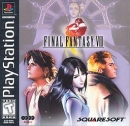dharh said:
jarrod said:
dharh said:
Take a closer look at the memory. 4mb of memory for the DS and 2(main)+1(vid)+.5(sount)=3.5mb of memory for the PS1. That doesn't seem like far less memory to me. Also the highest reached polygon count of the PS1 was about 150k textured lit polygons, though SONY ( ) said the theoretical output was 1 million 'flat, unshaded, unlit polygons.' Ultimately its the DS additional features which limit the DS to match raw power of PS1 and PSP. The wireless, the 2 screens, the touch sensitivity, the lockout limit on polygons, the smaller media. ) said the theoretical output was 1 million 'flat, unshaded, unlit polygons.' Ultimately its the DS additional features which limit the DS to match raw power of PS1 and PSP. The wireless, the 2 screens, the touch sensitivity, the lockout limit on polygons, the smaller media.
Of course the DSi trounces all of those systems.
|
No, 150k textured was the original peak N64 figure (later revised down to 100k). Peak PS1 was 180k textured polys (revised down from 500k), peak Saturn was 200k textured "quads" (original figure, never revised). None of them were "in game" figures, none of the manufacturers actually gave "in game" specs until Nintendo with GameCube. Also, I was off on the DS "in game" figure, it's 120k. It also has a higher pixel fill rate (30 million/sec versus just 4000/sec for PS1). The big advantage for DS 3D comes it in having hardware Z-buffering however, which keeps polygons more stable and "in order" and also allows a lot of post processing effects that'd be impossible on PS1. It's basically a class ahead of it for 3D (like N64 was).
Also, I was only comparing main RAM. DS also has a 656KB video buffer, 512KB dedicated for texture memory, 64KB work RAM for the ARM9, 32KB for the ARM7 and 256KB flash for the OS and WiFi settings. Plus, DS is RAM expandable, unlike PS1.
edit: DS does have a lockout ceiling for polys though (the 120k figure). This is to ensure locked framerates (120k pps is for 60 fps). Sega's Model 2 board (which was used for VF2 and Sega Rally) actually used a similar locked limit method.
|
You bring up N64, Saturn, why exactly? Highest count I found in a PS1 game was 150k, but if you've got a better game I ain't gonna argue. And actually the pixel count of the DS vs PS1 needs a closer look as well. The DS has a max 1024x1024 texture size of pixels or 1048576 pixels. The PS1 on the other hand has max 4000 8x8 pixels or 256000 pixels. While thats 4 to 1, its again, the polygon limit that gives the DS the disadvantage (in that department anyway).
|
I just brought up Saturn and N64 for relative figures of same class hardware. BTW, what game did you find 150k textured, shaded polys in, and what was the framerate? My understanding was that PS1 games tended to peak around 90k pps @ 30 fps. I thought Tekken 3 was good example of a high end title @ 60 fps though (ranging 60-80k pps), you actually found something better?
The DS locked ceiling is in place to ensure stable framerates (like previous Sega arcade hardware), I'd view it less as a disadvantage and more as a guide. Plus DS throws tons of 3D effects at you "for free" (cellshading, gouraud shading, environment mapping, shadow volumes, specular lighting, alpha blending, fog, etc) and even had a crude T&L engine with 4 "free" directional lights and even ST3C texture compression. DS' 3D spec was basically designed to be the anti-N64 (which took major performance hits the more effects you piled on), it really is the all around most capable system for 3D when compared to similar class consoles (N64, PS1, Saturn) and DS would rank only behind Saturn in 2D capability. I'd say the proof is in the pudding though, looking at high end 3D DS RPGs like FF Gaiden or DQIX or SaGa2 or Ninokuni, and they pretty much blow away anything comparable on PS1 or Saturn technically.
I also found the peak transform figures for each by googling, PS1 is 1.5m verticies/sec while DS is 4m verticies/sec.
The real downfall for DS 3D imo isn't the above-PS1-in-game polygon ceiling. It's in it method for texture filtering, which is fixed point (resulting in those "blocky" looking textures) and lacks any bi-linear filtering (which N64 at least supported). Considering the screen size, Nintendo likely figured the performance hit wasn't worth the trade off, but it'd have been nice to have the option imo.






































 ) said the theoretical output was 1 million 'flat, unshaded, unlit polygons.' Ultimately its the DS additional features which limit the DS to match raw power of PS1 and PSP. The wireless, the 2 screens, the touch sensitivity, the lockout limit on polygons, the smaller media.
) said the theoretical output was 1 million 'flat, unshaded, unlit polygons.' Ultimately its the DS additional features which limit the DS to match raw power of PS1 and PSP. The wireless, the 2 screens, the touch sensitivity, the lockout limit on polygons, the smaller media. 



 If you're not impressed by DS sales, then that's fine, but I'm quite sure you're about the only person on earth who thinks so.
If you're not impressed by DS sales, then that's fine, but I'm quite sure you're about the only person on earth who thinks so.














 (I wasn't even thinking about PSP/PS1 being more capable than the DS, at the time)."
(I wasn't even thinking about PSP/PS1 being more capable than the DS, at the time)."

